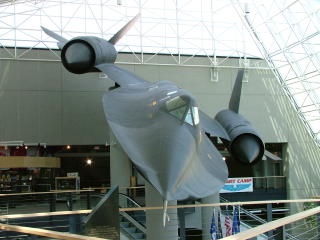There is a REALLY cool aerospace museum right outside of Omaha, named the Strategic Air & Space Museum. It originally started in 1959, at Offutt AFB as the Strategic Aerospace Museum. Gen. Curtis LeMay provided the vision for the starting of the museum, and over the years, its focus changed to preserving the heritage of the Strategic Air Command, hence the name change to the SAC Museum (which is what I still call it). Up until 1998, the museum was based at small building right outside Offutt AFB; an unused portion of the Offutt tarmac was where most of the aircraft were stored. In 1998, the museum finally had enough money to move to a purpose-built facility outside of Omaha near Mahoney State Park, where the airplanes were able to be stored inside, preventing further deterioration. Later, the museum changed its name to its current one, in light of its expansion (it actually has several aircraft that were a part of TAC, rather than SAC).
Anyway, the whole point of this is that I took a visit to the museum today.
And I took pictures...and blogger now has a hosting service. I have bandwidth to waste.
So here we go...first up is a U-2C, a version of the famous spy-plane that Gary Powers was shot down in.

Next is a view that MiG-15 pilot would hate to see...a look down the throat of an F-86 bearing down.

Here's an excellent shot of one of the Sabre's rivals: an F-84F Thunderstreak, SAC's escort fighter turned tactical nuclear strike fighter.

We'll travel back in time a bit, taking a look at a classic warbird, the B-25. This is actually a B-25N trainer, hence the lack of guns and gun turrets. This airframe used to have some suggestive nose art, along the lines of a "Texas Rose," but they got rid of it when they restored it from its years of outdoor storage. Pity

Here's a stablemate of the Mitchell, albeit one that had a much longer career, spanning a quarter of a century, serving in WWII, Korea, Vietnam, and too many third-world brushfire conflicts to count. This particular model of the A-26 unfortunately has its gun ports in the nose covered, because it is a de-gunned version known as the B-26, lacking gun turrets and forward firing machine guns; it probably saw service in Vietnam as an interdictor. While it looks fearsome now, picture it with six .50 machine guns poking out of the nose and festooned with gun turrets.

Closing out our look at WWII aircraft is one that I'm sure most of you are familiar with, the B-17 Flying Fortress. This particular model is a -G variant, with the chin turret. The museum really did a bang-up job on the restoration. It looks like it just came out of the factory.
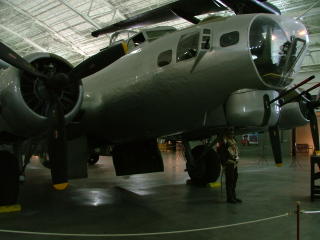
Jumping a generation, we come to the B-36, one of the (if not the) biggest bomber ever procured by the USAF. Designed in the middle of WWII to be able to launch unrefueled intercontinental bombing raids, it became a white elephant after the USSR improved its air defenses, making its altitude advantage negligable. It changed roles into a strategic reconaissance aircraft, able to map the entire country of Portugal in one pass.

To give you an idea of how big the B-36 is, here's a picture of its landing gear.
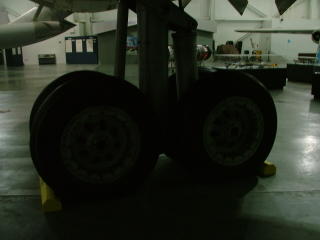
Also with the B-36 were two accessories: the shell of a thermonuclear bomb, and the XF-85 Goblin. The Goblin was a parasite fighter designed to be carried on a trapeze in the bomb bay of the B-36, flying off to defend the bomber in enemy territory, and then reattaching to the bomber for a ride home.
The bomb:

And the Goblin:

Bridging the gap between the WWII aircraft and the B-36 is the USAF's first jet powered bomber, the B-45. Too slow and underpowered to be a bomber, it saw service in the RAF over the USSR and in the USAF in North Korea as the RB-45, a tactical recon aircraft. Relatively fast and maneuverable for its size, it stayed in service until the mid-1950s.

The next generation of bomber, after the B-45 and the B-36, is the B-47, America's first swept-wing bomber. It defended America for years, doing everything from standing airborne alert to dodging Soviet fighters on overflights.

Following the Stratojet was the BUFF, still defending our country after over 50 years of service. Cold War, Vietnam, Desert Storm, Iraqi airstrikes, Afghanistan, and Iraq part two.

Joining the B-52 in Vietnam was the B-57, Martin's Americanized version of the British Canberra, their first jet bomber. This airplane has always struck me as having good lines. Judge for yourself.

Now it's time for some missiles. First up is the AGM-129 Shadow, a stealthy, extended range air-launched cruise missile designed for use with America's strategic bomber force.

Then we have the Quail, a decoy missile launched from the B-52 that was designed to mimic the radar signature of a BUFF.
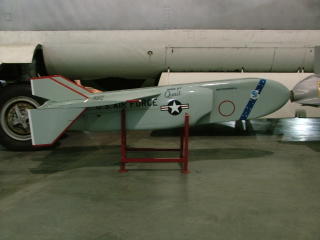
Next to the Quail is something that should look familiar to anyone who served with a BUFF unit during the Cold War. The AGM-86 ALCM is the cruise missile intended for use by the B-52s in the event the Cold War went hot. As it turned out, most of the stocks were depleted in Desert Storm after being re-armed with conventional warheads. A pretty cool looking misile.
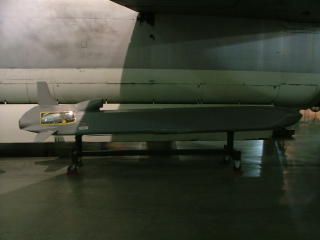
An even cooler looking missile is the Hound Dog, a large nuclear armed missile intended for use by B-52s to blow a way through Soviet air defenses.

Jumping from SAC to TAC, we come across the F-101, an interceptor turned tactical recon bird. One of the lesser known of the Century series of fighters.

Keeping with the TAC theme, here's a good picture of a TAC rescue amphibian, the HU-16. The day-glo paint on this bird is very cool, especially since the museum restored it.

A plane most people find ugly, but I find rather nice, is the F-111 Aardvark. This particular model is actually the FB-111, a version built for SAC as a nuclear strike aircraft. Something interesting about the Aardvark is the fact that instead of ejection seats it has an ejection capsule, which you can see next to the aircraft.
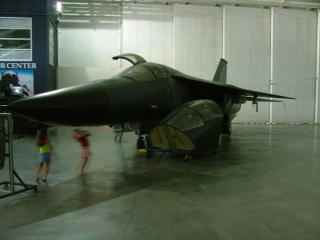
To round out the first hangar, we have a Soviet aircraft, the MiG-21. This particular one is painted up in a NVAF paint scheme. It needs a thorough restoration, but still looks nice.

Starting off the second hangar, there's a very nicely restored C-119, with clamshell doors and twin booms. This aircraft is used for sleep-ins with Scout groups and such. The kids actually get to sleep inside the aircraft on bunks.
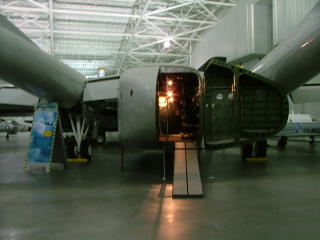
Another, slightly older, transport aircraft in the museum is the C-47. Should be self explanatory to most of you.

Keeping with the transportation theme, here's an early helicopter, the H-19. This is the forerunner of the UH-34, made famous by its early service in Vietnam.

Going back to TAC, this is a picture of the F-102, a contemporary interceptor of the Voodoo that was shown earlier.
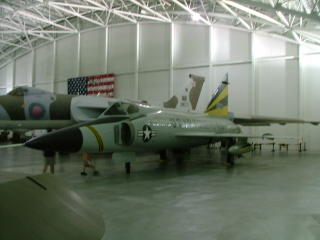
The sole British aircraft in this museum is one of the best that they built, in my opinion. The Avro Vulcan started service in the 1950s as part of the RAF's V-Force. After being replaced by submarine based ICBMs, it faded off into the twilight as a recon bird and tanker, being resurrected for one last hurrah in the Black Buck series of missions against the Falklands after they were invaded by Argentina.
Here's a few:


One of my most favorite aircraft is the B-1. Here's a good picture of the 150,000 pounds of thrust it puts out.

And if that doesn't give you a sense of its power, look at the size of this wing acutator, able to move 70,000 pounds worth of wing.
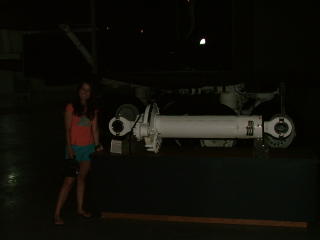
Finishing everything off, a picture of the excellent display of the SR-71 that greets you as you enter. You can definitely see why this plane got the nickname of Habu (a famous pit viper).
